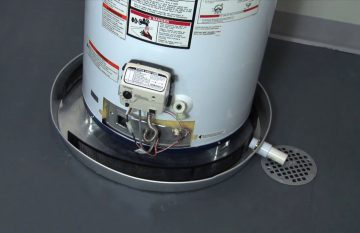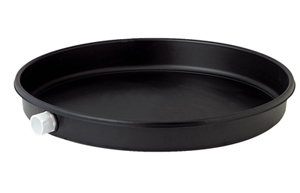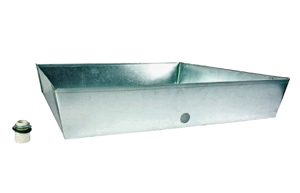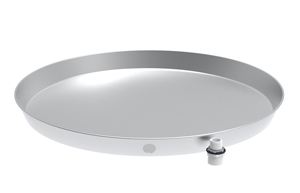Is a Drain Pan Required Under a Water Heater?

The water heater is an essential part of your home. However, the water volume it carries can pose a significant risk for water damage if a failure occurs. You can take a few steps to mitigate the risk of water damage, one of which is installing a water heater drain pan.
The plumbing codes change every few years. One of the changes in recent years is the requirements for drain pans under water heaters. If it’s time to replace your water heater (or do drain service on the existing water heater), you may need to install a drain pan under the water heater.
So, is a drain pan required under a water heater? In most cases, Yes. Whether you need a drain pan under a water heater is mostly determined by the location where it is installed. If your water heater is installed in an attic or ceiling space or inside the interior living space, a drain pan is required under your water heater. Drain pans are not required under the water heaters installed in garages in most states.
Additionally, the drain pan also needs a drain pipe installed that drains to the building’s exterior.
When Do You Need a Drain Pan Under a Water Heater?
If you’re unsure of whether you need a drain pan under your water heater or not, this article will help you figure it out. We’ll also talk about the type of water heater pan you should buy, as well as how to ensure your water heater pan has been installed correctly.
When the International Plumbing Code requires it
504.7 Required pan – Where a storage tank-type water heater or a hot water storage tank is installed in a location where water leakage from the tank will cause damage, the tank shall be installed in a galvanized steel pan having a material thickness of not less than 0.0236 inch (0.6010 mm) (No. 24 gage), or other pans approved for such use.
504.7.1 Pan size and drain – the pan shall be not less than 11/2 inches (38 mm) in-depth and shall be of sufficient size and shape to receive all dripping or condensate from the tank or water heater. The pan shall be drained by an indirect waste pipe having a diameter of not less than 3/4 inch (19 mm). Piping for safety pan drains shall be of those materials listed in Table 605.4.
504.7.2 Pan drain termination. – The pan drain shall extend full size and terminate over a suitably located indirect waste receptor or floor drain or extend to the exterior of the building and terminate not less than 6 inches (152 mm) and not more than 24 inches (610 mm) above the adjacent ground surface. Where a pan drain was not previously installed, a pan drain shall not be required for a replacement water heater installation.
Here are a few of the more common scenarios in which you might be required to use a water heater pan:
- Anytime your water heater is located above the ground level
- Anytime your water heater is located in an attic or ceiling location
- When your water heater is located in an interior living space
We’ll discuss why drain pans for the water heater are required in these situations in the upcoming sections but know that you might not have a choice in the matter if your locality’s building code mentions water heater pans.
When your water heater is above the ground floor or inside an attic
Installation of a drain pan becomes especially important if your water heater is located above your home’s ground floor. If a leak happens and you don’t have a drain pan in place, you could be looking at a lot of costly structural damage.
Leaking water in a multi-level home will drip through your walls and ceiling, which can cause an outbreak of mold or even harm the structural integrity of your house.
If you do sustain a major leak from a water heater on the upper level of your house, you’ll need to make sure the water damage isn’t affecting any of the load-bearing walls in your home.
Failure to do this could damage these walls, which can result in a partial or total collapse of your house. As such, I highly recommend placing your water heater in the basement, as leaks down there won’t run the risk of major structural damage.
When your water heater is in a living area
While most water heaters are tucked away in a basement corner, some families don’t have the luxury of an out-of-the-way water heater.
If your water heater is located in an area that you and your family use for activities, installing a water heater pan is a pretty inexpensive way to ensure a leak doesn’t damage your belongings or make the room unusable.
This is especially true if the room contains expensive electronics or live electrical outlets, as small leaks can destroy your equipment or even create a fire hazard.
What kind of water heater pan should I buy?
When choosing a water heater pan, you’ll need to consider two distinct characteristics: material and size.
Choosing the right material
Water heater pans are most often made out of aluminum, steel, or plastic.
If you’re looking for something durable, you should stick to a steel or aluminum pan.
Plastic pans typically have shoddier manufacturing than metal alternatives, and frequent temperature changes or misuse can cause them to crack and become unusable.

Steel pans are the most durable type, but they are also on the pricier side.

Aluminum pans are almost as durable as steel pans, so reducing cost makes an aluminum pan the right choice for most people.

Choosing the right size
Finding the right size of a water heater drain pan can be a daunting process. To figure out the optimal size for your water heater pan, you can follow this step-by-step process:
- Get some measuring tape.
- Figure out how wide the water heater is. You can do this by placing the tape measure at one of the heater’s top edges and measuring the distance to the opposite edge.
- Once you have the width measured, you can start looking for a water heater pan. Make sure the pan is at least two inches wider than your water heater. So if your heater is 30 inches wide, you’ll need a pan that is at least 32 inches wide.
After you’ve figured out how wide of a pan you need, you need to decide on a depth. While you might initially think that a deeper pan is automatically better, this isn’t always the case.
Drain pans are only meant to prevent water damage caused by slow, steady leaks. If your heater is leaking so much water that a shallow pan can’t drain it quickly enough, you’re probably going to end up dealing with water damage no matter how deep your pan is.
The pipes that drain pans direct water can only handle so much liquid at once. A deeper pan will only delay the inevitable if your heater ever springs a leak too large for your pan to deal with.
How to Install a Drain Pan Under an Existing Water Heater
Once you buy a water heater drain pan, you need to make sure you install it correctly. This is a task typically left to a professional, but it’s certainly possible to do it yourself if you want to save money.
If you’d like to go the DIY route, you can use this step-by-step guide to installing your drain pan:
- Shut off the water lines leading to and from your water heater. If you’d like to be thorough, you can also disconnect them.
- Disconnect the service lines attached to your heater.
- If you have an electric water heater, you should turn off the main power supply.
- Drain the tank of water by opening the T&P valve. You shouldn’t attempt to move the tank before draining the water, as the water’s increased weight will make it dangerous to lift.
- Find a second person is needed to help you lift the water heater.
- Lift the heater and place the drain pan under it. Make sure to point the discharge hole in the direction your drainage pipes will be in.
- Place the heater inside of the drain pan and reattach the water lines.
- Close the T&P valve and the drain valve.
- Place a paper towel over all of your connections to see if anything is leaking.
- Reconnect the supply lines. If you have an electric heater, turn the main power back on. If you have a gas heater, relight the burner.
- Attach the drainage pipe to the drain pan discharge hole. This pipe will remove water from the pan, so it doesn’t accumulate and overflow.






